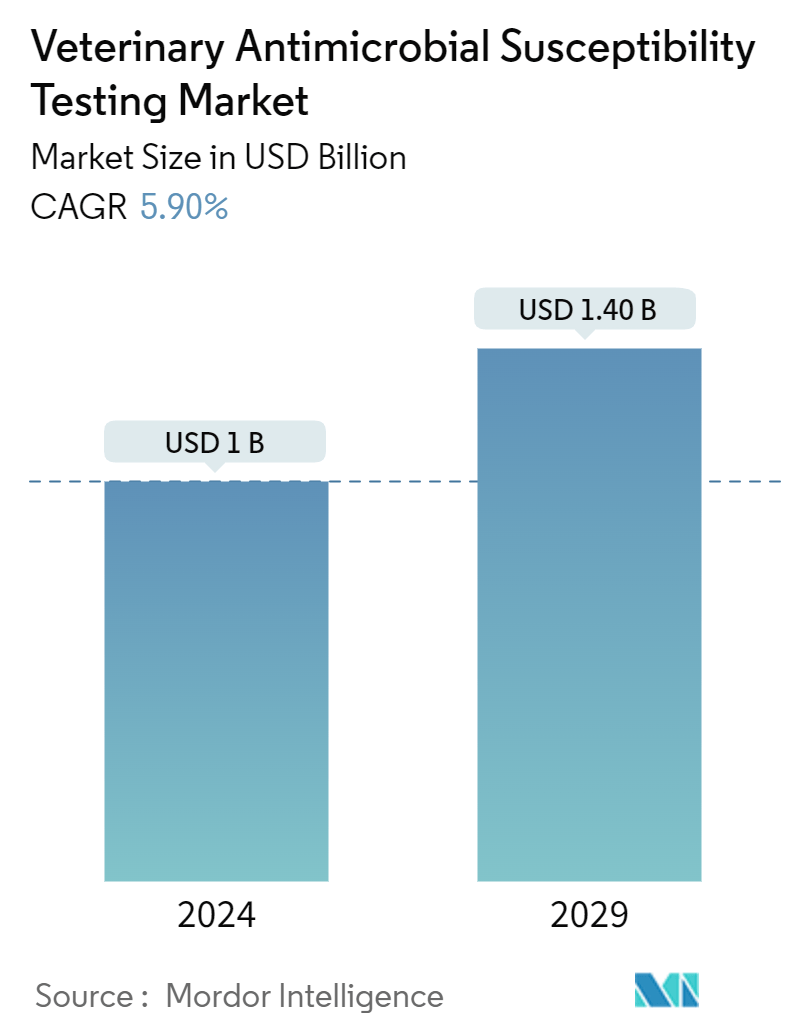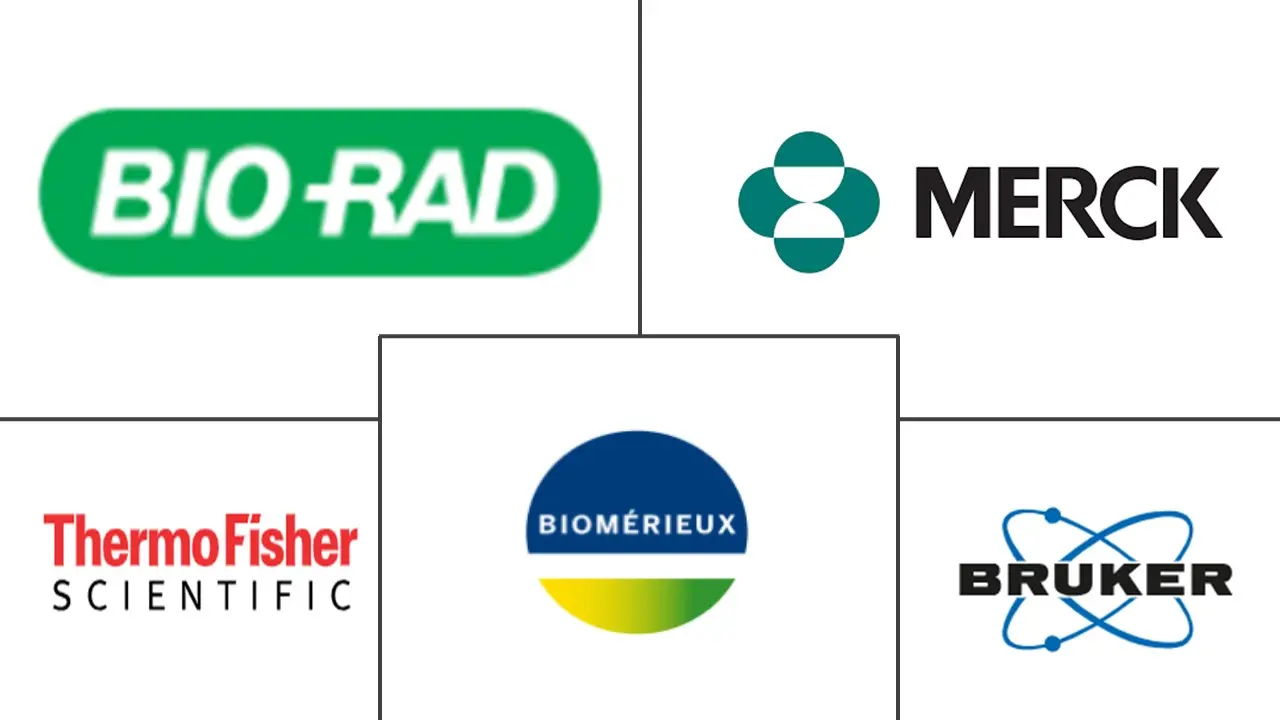Market Size of Veterinary Antimicrobial Susceptibility Testing Industry

| Study Period | 2019 - 2029 |
| Market Size (2024) | USD 1 Billion |
| Market Size (2029) | USD 1.40 Billion |
| CAGR (2024 - 2029) | 5.90 % |
| Fastest Growing Market | Asia Pacific |
| Largest Market | North America |
| Market Concentration | Low |
Major Players
*Disclaimer: Major Players sorted in no particular order |
Veterinary Antimicrobial Susceptibility Testing Market Analysis
The Veterinary Antimicrobial Susceptibility Testing Market size is estimated at USD 1 billion in 2024, and is expected to reach USD 1.40 billion by 2029, growing at a CAGR of 5.90% during the forecast period (2024-2029).
Rising antimicrobial resistance (AMR) had been ringing alarm bells across the world long before COVID-19. Globally, there was an alarming trend of multi-drug resistance as the pandemic grappled. As per the article published during Covid under the title “Antimicrobial susceptibility patterns of respiratory gram-negative bacterial isolates from COVID-19 patients in Switzerland,” the development of bacterial superinfections in ventilated COVID-19 patients was impacted by high levels of AMR, which in some situations necessitate continued modification of antibiotic therapy. The result of drug-resistant infections made illnesses more prolonged. Death rates became more severe and common. COVID-19 significantly impacted the market studied.
AMR poses a global problem that jeopardizes the effectiveness of treatments for bacterial infections and hampers essential medical advancements in veterinary medicine, such as complex surgeries and chemotherapy. According to the World Health Organization (WHO), if not effectively managed, AMR could lead to an estimated 10 million annual deaths by 2050, a number comparable to other severe illnesses such as cancer.
The rise of AMR has emphasized the pivotal role of clinical microbiology laboratories in promoting the responsible use of antibiotics and guiding appropriate treatment choices. Susceptibility testing is crucial in providing guidance for antimicrobial treatment, as antimicrobial resistance is one of the top public health challenges globally. Insufficient use or inadequate utilization of microbiological culture and antimicrobial susceptibility testing (AST), along with excessive reliance on empirical antibiotic treatment, can contribute to the worsening of AMR in veterinary healthcare. To address these challenges, a closer collaboration between diagnostic laboratories and healthcare providers is necessary to effectively implement antimicrobial stewardship practices, thereby accelerating the demand and leading the growth of the veterinary antimicrobial susceptibility testing market.
However, challenges such as high cost associated with testing and limited awareness and training gaps could impede innovation and rapid expansion of the veterinary antimicrobial susceptibility testing market. Despite acknowledging the importance of antimicrobial treatment, there remains a significant need to standardize the training of clinical microbiologists and the diagnostic procedures they use. This need is especially pronounced in the field of veterinary clinical microbiology, where additional challenges exist in fulfilling professional roles.
Improving the output of veterinary microbiology laboratories requires addressing specific issues, such as the harmonization of methodologies used for antimicrobial susceptibility testing (AST), the establishment of guidelines for interpreting and reporting AST results for animal pathogens, guidelines for detecting antimicrobial resistance mechanisms in animal isolates, standardization of diagnostic procedures for animal clinical specimens, and the increased training of veterinary clinical microbiology specialists.
Veterinary Antimicrobial Susceptibility Testing Industry Segmentation
Veterinary antimicrobial susceptibility testing involves the assessment of microbial susceptibility to antimicrobial agents in animals. It employs laboratory techniques to determine the effectiveness of antimicrobials against specific pathogens, aiding veterinarians in making informed decisions for effective treatment.
The veterinary antimicrobial susceptibility testing market is segmented by product type into disks and plates, culture media, automated testing systems, and other product types. By animal type, the market is segmented into companion animals [dog, cat, and others] and livestock [cattle, pigs, and others]). By end user, the market is segmented into veterinary reference labs, veterinary research institutes, and other end users. Geographically, the market is segmented into North America, Europe, Asia-Pacific, and Rest of the World. The report offers market sizes and forecasts in terms of value (USD) for the above segments.
| By Product Type | |
| Disks and Plates | |
| Culture Media | |
| Automated Testing Systems | |
| Other Product Types |
| By Animal Type | |||||
| |||||
|
| By End User | |
| Veterinary Reference Labs | |
| Veterinary Research Institutes | |
| Other End Users |
| Geography | ||||||||
| ||||||||
| ||||||||
| ||||||||
| Rest of the World |
Veterinary Antimicrobial Susceptibility Testing Market Size Summary
The veterinary antimicrobial susceptibility testing market is poised for significant growth, driven by the increasing global concern over antimicrobial resistance (AMR) and its impact on veterinary medicine. AMR poses a serious threat to the effectiveness of treatments for bacterial infections, complicating essential medical procedures such as surgeries and chemotherapy. The rise of drug-resistant infections has underscored the critical role of clinical microbiology laboratories in promoting responsible antibiotic use and guiding treatment decisions. Despite the challenges of high testing costs and limited awareness, the demand for antimicrobial susceptibility testing is expected to grow, fueled by the need for effective antimicrobial stewardship practices. Automated testing systems are playing a pivotal role in this market, offering efficient and standardized methods for assessing microbial susceptibility, thereby enhancing the speed and accuracy of testing processes.
The market landscape is characterized by a mix of established players and emerging companies, with key product launches and technological advancements driving growth. The presence of multiple market participants, including major companies like Merck KGaA, Bio-Rad Laboratories Inc., and Thermo Fisher Scientific Inc., contributes to the competitive environment. In North America, the market is further propelled by innovations such as the PA-100 AST System and the eQUANTTM system, which streamline testing procedures and improve diagnostic accuracy. Collaborative efforts among stakeholders, including government bodies, businesses, and educational institutions, are crucial in addressing antibiotic resistance and ensuring food security. The fragmented nature of the market, with a combination of diagnostic kits and testing services, reflects the ongoing efforts to combat AMR and enhance veterinary healthcare outcomes.
Veterinary Antimicrobial Susceptibility Testing Market Size - Table of Contents
-
1. MARKET DYNAMICS
-
1.1 Market Overview
-
1.2 Market Drivers
-
1.2.1 Rising Concerns about Antimicrobial Resistance (AMR)
-
1.2.2 Growing Pet Ownership and Intensive Livestock Farming
-
1.2.3 Regulatory Emphasis on Antimicrobial Use
-
-
1.3 Market Restraints
-
1.3.1 High Cost Associated with Testing
-
1.3.2 Limited Awareness and Training Gaps
-
-
1.4 Porter's Five Force Analysis
-
1.4.1 Threat of New Entrants
-
1.4.2 Bargaining Power of Buyers/Consumers
-
1.4.3 Bargaining Power of Suppliers
-
1.4.4 Threat of Substitute Products
-
1.4.5 Intensity of Competitive Rivalry
-
-
-
2. MARKET SEGMENTATION (Market Size by Value - USD)
-
2.1 By Product Type
-
2.1.1 Disks and Plates
-
2.1.2 Culture Media
-
2.1.3 Automated Testing Systems
-
2.1.4 Other Product Types
-
-
2.2 By Animal Type
-
2.2.1 Companion Animals
-
2.2.1.1 Dog
-
2.2.1.2 Cat
-
2.2.1.3 Others
-
-
2.2.2 Livestock
-
2.2.2.1 Cattle
-
2.2.2.2 Pigs
-
2.2.2.3 Others
-
-
-
2.3 By End User
-
2.3.1 Veterinary Reference Labs
-
2.3.2 Veterinary Research Institutes
-
2.3.3 Other End Users
-
-
2.4 Geography
-
2.4.1 North America
-
2.4.1.1 United States
-
2.4.1.2 Canada
-
2.4.1.3 Mexico
-
-
2.4.2 Europe
-
2.4.2.1 Germany
-
2.4.2.2 United Kingdom
-
2.4.2.3 France
-
2.4.2.4 Italy
-
2.4.2.5 Spain
-
2.4.2.6 Rest of Europe
-
-
2.4.3 Asia-Pacific
-
2.4.3.1 China
-
2.4.3.2 Japan
-
2.4.3.3 India
-
2.4.3.4 Australia
-
2.4.3.5 South Korea
-
2.4.3.6 Rest of Asia-Pacific
-
-
2.4.4 Rest of the World
-
-
Veterinary Antimicrobial Susceptibility Testing Market Size FAQs
How big is the Veterinary Antimicrobial Susceptibility Testing Market?
The Veterinary Antimicrobial Susceptibility Testing Market size is expected to reach USD 1 billion in 2024 and grow at a CAGR of 5.90% to reach USD 1.40 billion by 2029.
What is the current Veterinary Antimicrobial Susceptibility Testing Market size?
In 2024, the Veterinary Antimicrobial Susceptibility Testing Market size is expected to reach USD 1 billion.

